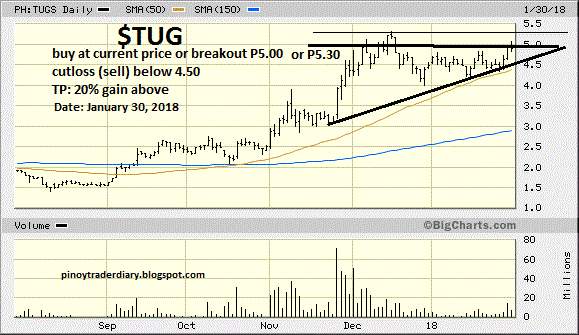A lot of people have been asking me about position sizing and how do I manage my risk, so I think it is about time for me to explain it here.
To put it simply, it all starts with my
risk tolerance.
What is risk tolerance? For me, it is
the percentage of my capital that I am willing to risk in every trade.
I'm gonna give you an example to make it clear.
Let's say for example that you have P100,000 starting capital. How much of it are you willing to lose in every trade you make? Is it P2000, P5000, or more? The amount is entirely up to you.
Let's say you are willing to lose only P2000 per trade. So your risk tolerance is 2% of your trading capital.
Capital = P100,000
Risk tolerance = 2%
Risk/trade = P2000
Let's do a trade example to make it more clear:
Supposed that you want to buy $STI at P1.80.
You also want to put your stop at P1.60.
 |
| chart from www.bigcharts.marketwatch.com |
All you have to do is calculate how many shares you have to buy for you to be stopped at your 2% risk tolerance in case your trade goes wrong.
Let's do the math.
Total capital x Risk tolerance % = Risk per trade
(P100,000 x 2%) = P2000
Buy price - Stop loss price = Risk per share
(1.80 - 1.60 = .20 cents)
Risk per trade divide by(/) Risk per share = Position size
(P2000/.20 cents = 10,000)
It means you can
buy 10,000 shares of $STI at P1.80 price with a stop loss at P1.60.
10,000 shares of $STI at P1.80 will be worth P18,000.
If it breaks its support at P1.60 and you sell it, it will total in cost at approximately P16,000.
(P18,000-P16,000 = P2,000)
You lost P2000, which is still within your 2% risk tolerance.
It is that simple.
Notes:
This is just an example, you can choose your own % in risk tolerance. You can even include broker commission charges if you want to be precise in your calculation.
It is advisable not to go beyond 2% risk tolerance to preserve your capital. This way, you can minimize losses even if you are always stopped out in your trades. As long as you keep winners run and stick to your cut loss discipline, you will end up on the profit side most of the time. Besides, if you're always stopped out it means you need to work on your entry strategy.
You can add more position if the price of the stock goes up.
Always trail your stop. How to determine it is entirely up to you. You can use support and resistance, moving averages, Fibo retracement or whatever it is that works for you.
Hit me up for question.
Alex







